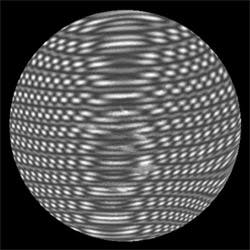Measuring the surfaces of thin, plane-parallel optics has been historically problematic because the front and back surfaces are so close together. Multiple reflective surfaces in close proximity make it very difficult – if not impossible – for standard interferometry techniques to obtain reliable measurements.
Why is it Difficult?
When trying to measuring thin optics with traditional phase-shifting interferometry (PSI), a second reflection is returned to the interferometer from the back surface of the optic. This results in multiple overlapping interference fringes resulting in a complex pattern (shown in the image above) that PSI cannot accurately analyze.
Shortfalls of Traditional Methods
Several work-around methods have been developed to overcome the fundamental limitations of measuring thin plane-parallel optical components with PSI, such as coating the back surface with materials that reduce or eliminate the secondary reflection. Applying black paint, coloring with a dark marker, or spreading petroleum jelly on the back surface takes time, adds undesirable steps to the metrology process, and carries the risk of damaging or distorting a thin component when applying or removing the coating.
ZYGO Patented Technology Makes It Quick and Easy
Fortunately, ZYGO's innovative engineering staff developed (patented) technologies to distinguish each surface of a thin plane-parallel optic, and characterize the quality of both in a single measurement, even for components thinner than 1 millimeter.
Bonus: Homogeneity and Thickness Variation Measurement
The capability to measure optical homogeneity and total thickness variation (TTV) is a standard feature of ZYGO's Verifire™ MST laser interferometer system. A simple, two-measurement process is all it takes. Traditional methods, involving the use of oil-on plates, or requiring the optic to have a degree of wedge, are no longer necessary.
Learn More About It
For a more in-depth look at the measuring multiple surfaces of thin optical components, download the technical article How to Measure Thin Parallel Optics.



